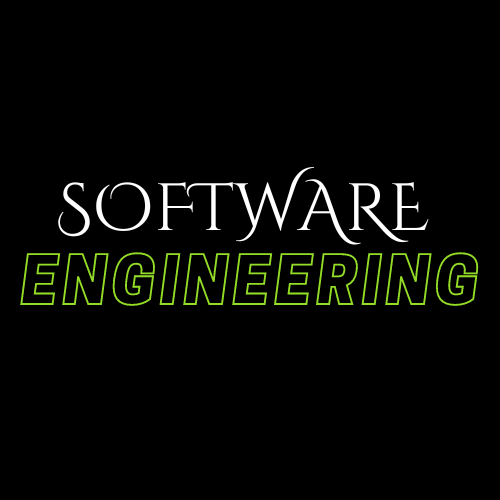About this course
Software Engineering course is designed to equip students with the practical skills needed in the field of software development. The course covers a wide range of topics including software design, coding, debugging, testing, and maintenance.
Whether you’re a beginner looking to start a new career or a professional seeking to upgrade your skills, this course is perfect for you.
Requirements
OpenMindend and Agility
Comments (0)
Software engineering is a part of computer science that focuses on creating software applications. It uses a systematic and disciplined approach to develop, operate, and maintain software.
Software engineers use engineering principles and programming knowledge to create software solutions. They design and build computer systems and applications to solve problems in the real world.
Software engineering is an art form, a dance of logic and creativity that breathes life into the digital realm. It is a methodical, scientific, and disciplined approach to the creation, operation, and maintenance of software.
Imagine embarking on a thrilling journey, a quest to create something extraordinary. This is the essence of the Software Development Life Cycle (SDLC). It’s not just a structured process, but a grand adventure that guides you in designing, developing, and testing top-notch software.
Think of SDLC as your trusty map, outlining every step of your software development voyage in meticulous detail. Its ultimate goal? To help you craft high-quality, maintainable software that perfectly meets the needs of its users.
Each stage of the SDLC is like a landmark on your journey. It’s meticulously planned to ensure every task is performed efficiently, keeping your adventure on track. The result? You reach your destination - delivering exceptional software that not only meets user requirements but does so cost-effectively and within a set timeframe.
A successful software project is characterized by its production at a reasonable cost, within an acceptable timeframe, and with high quality.
Cost: The primary expense in software production is the human resources involved. Therefore, the cost of software development is typically measured in person-months, reflecting the effort spent on the project. Productivity in the software industry varies, with fresh code writing ranging from a few hundred to over 1000 lines of code (LOC) per person per month.
Schedule: The project timeline is a crucial aspect. Current business trends demand a reduced time-to-market for products, meaning the cycle from concept to delivery should be minimized. This necessitates faster software development within the specified timeframe.
Quality: Quality is a fundamental objective in software engineering and forms the basis of many business strategies. Developing high-quality software not only meets user requirements but also reduces maintenance costs and improves overall user satisfaction.
The ISO/IEC 9126 standard, developed by the International Organization for Standardization (ISO) and the International Electrotechnical Commission (IEC), is a framework for evaluating software quality. It has been replaced by ISO/IEC 25010:2011. The standard is divided into four parts: quality model, external metrics, internal metrics, and quality in use metrics.
The fundamental objective of the ISO/IEC 9126 standard is to address some of the well-known human biases that can adversely affect the delivery and perception of a software development project. By clarifying, then agreeing on the project priorities and subsequently converting abstract priorities to measurable values, ISO/IEC 9126 tries to develop a common understanding of the project’s objectives and goals.
Functional requirements are the specific features a software system should perform, such as tasks, outputs, and functions. They are what the system should do. On the other hand, non-functional requirements are the performance standards or qualities that the system should have, like security, reliability, and usability. They describe how well the system does what it should do.
Requirements elicitation is a crucial part of the requirements engineering process in software engineering. Its goal is to gather and define the requirements for a software system based on a clear understanding of the customer’s needs. This process is vital as it influences the scope, budget, and time estimation for a project. The elicitation process involves gathering information from all stakeholders about the software. The types of requirements include Business, Stakeholder, Solution (functional and non-functional), and Transition requirements.
Analysis in requirement analysis plays a pivotal role in software engineering. It involves a thorough evaluation and refinement of gathered requirements. This process ensures that the developed software aligns with its intended purpose and effectively serves its users. Understanding this concept is fundamental to successful requirement analysis in software engineering.
UML Use Case and Class Diagrams are integral to requirement analysis in software engineering. Use Case Diagrams help understand the dynamic behavior of a system, while Class Diagrams provide insight into its static structure. Together, they offer a comprehensive view of what the system is supposed to do and how it is organized. Understanding these concepts is fundamental to successful requirement analysis in software engineering.
While Requirements Validation ensures that the defined requirements are error-free and match the target system, Requirements Management handles changes to these requirements throughout the development process. Both these aspects are crucial to ensuring that a software system meets its intended purpose and serves its users effectively.
System design is a vital step in software systems engineering that addresses the development of complex software-intensive systems. It involves analyzing, designing, developing, testing, and maintaining a broad range of software based on specific user needs.
Architectural patterns are general, reusable solutions to commonly occurring problems in software architecture within a given context. They address various issues in software engineering, such as computer hardware performance limitations, high availability, and minimization of business risk. Examples of architectural patterns include the client-server pattern, event-driven pattern, microkernel pattern, and microservices pattern.
Scalability in system design refers to the ability of a system to handle an increasing workload, both in terms of data volume and user requests, without compromising its performance. Scalability can be achieved via two methods: vertical scaling (adding more resources to a single server) and horizontal scaling (adding new machines).
Component-based software engineering (CBSE), also known as component-based development (CBD), aims to build software out of loosely coupled, modular components. It emphasizes the separation of concerns among different parts of a software system. Each component encapsulates a set of related functions or data and communicates with other components via interfaces.
Data modeling is the process of creating a visual representation of either a whole information system or parts of it to communicate connections between data points and structures. The goal is to illustrate the types of data used and stored within the system, the relationships among these data types, the ways the data can be grouped and organized, and its formats and attributes.
Security considerations in system design involve building security into IT development processes. This results in more cost-effective, risk-appropriate security control identification, development, and testing. It's important to ensure that networks and technologies are designed and built securely as they underpin modern life.
Object-Oriented Design (OOD) in software engineering involves several key principles and techniques. These include object-oriented design principles like encapsulation, inheritance, polymorphism, and abstraction. It also involves the use of UML (Unified Modeling Language) for visualizing and documenting software systems, and the application of design patterns to solve common problems. Object modeling techniques are used to identify objects and create diagrams. The designed objects are then implemented into code using an object-oriented language. These objects can be mapped into relational databases or using object-relational mapping techniques. Testing is performed at various levels including unit testing, integration testing, and system testing to ensure the software functions as expected. Lastly, software quality is ensured by meeting specified requirements and achieving customer satisfaction.
Software design transforms requirements into an implementable form using multiple abstraction levels from architecture to detailed modules. Modularization, concurrency, and achieving high cohesion and low coupling improve design quality. Thorough verification prevents later issues. Overall, software design lays the foundation for high-quality implementation and product success.
Choosing a programming language for software development depends on your project requirements, the learning curve of the language, community and library support, performance needs, cross-platform development requirements, and your career goals. For instance, JavaScript is often used for web development, while Python is preferred for data analysis and machine learning. Languages like Python and JavaScript are beginner-friendly and have large user communities. If your software requires high performance, languages like C++ or Java might be more suitable. For software that needs to run on multiple platforms, consider a language like Java or Python. Lastly, if you’re learning programming for career advancement, consider the demand for different programming languages in the job market.
reading text
Developing high-quality software involves adopting coding standards to promote uniformity and comprehension, conducting code reviews through walkthroughs and inspections to find errors proactively, producing internal and external documentation to aid understanding, use and maintenance over time, and employing testing methods like cleanroom that focus on prevention rather than detection of defects by avoiding execution-based testing and emphasizing formal specifications, incremental development, and rigorous static analysis through inspection and verification, all combined with the goal of catching defects earlier in the lifecycle when fixes are cheaper to produce code that strictly meets specifications and supports changes while facilitating decreased impacts of turnover - though some techniques require more initial time, they result in fewer costly bugs downstream and standards streamline processes overall raising both quality and productivity through upfront investments.Developing high-quality software involves adopting coding standards to promote uniformity and comprehension, conducting code reviews through walkthroughs and inspections to find errors proactively, producing internal and external documentation to aid understanding, use and maintenance over time, and employing testing methods like cleanroom that focus on prevention rather than detection of defects by avoiding execution-based testing and emphasizing formal specifications, incremental development, and rigorous static analysis through inspection and verification, all combined with the goal of catching defects earlier in the lifecycle when fixes are cheaper to produce code that strictly meets specifications and supports changes while facilitating decreased impacts of turnover - though some techniques require more initial time, they result in fewer costly bugs downstream and standards streamline processes overall raising both quality and productivity through upfront investments.Developing high-quality software involves adopting coding standards to promote uniformity and comprehension, conducting code reviews through walkthroughs and inspections to find errors proactively, producing internal and external documentation to aid understanding, use and maintenance over time, and employing testing methods like cleanroom that focus on prevention rather than detection of defects by avoiding execution-based testing and emphasizing formal specifications, incremental development, and rigorous static analysis through inspection and verification, all combined with the goal of catching defects earlier in the lifecycle when fixes are cheaper to produce code that strictly meets specifications and supports changes while facilitating decreased impacts of turnover - though some techniques require more initial time, they result in fewer costly bugs downstream and standards streamline processes overall raising both quality and productivity through upfront investments.
Debugging is the process of identifying and resolving issues or defects in software code. It involves analyzing and troubleshooting the program to locate and understand the root cause of errors, bugs, or unexpected behavior. Debugging often involves using tools or techniques to trace the execution path, examine variables, values, and data structures, or perform step-by-step execution to identify and fix the problems. The goal of debugging is to ensure that the software operates correctly, meets requirements, and functions as intended.
Software testing is the process of evaluating the quality, functionality, and performance of a software application or system. It is done to ensure that the software meets the required standards, is bug-free, and functions as intended. Testing is essential to detect and fix any errors or bugs before the software is put into use by users. Various techniques, tools, and methodologies are used to conduct software testing, such as manual testing, automated testing, functional testing, performance testing, etc. Overall, software testing is a critical part of the software development lifecycle to deliver reliable and high-quality software products.
The Software Testing Life Cycle (STLC) is a systematic process used to ensure the quality and effectiveness of software applications. It involves distinct phases that include planning, designing, executing, and evaluating the software testing activities.
The first phase of STLC is the requirement analysis, where the testing team thoroughly examines software requirements to understand its functionalities and expected outcomes. The next phase is test planning, where the testing strategy, test cases, and test data are planned and documented.
After test planning, the design phase begins, where the testers design test cases and test scenarios based on the requirements. This includes creating test conditions and identifying necessary resources for testing. Once the design is complete, the test execution phase begins, in which the actual test cases are executed, and the software is closely monitored for any defects or issues.
In the test closure phase, the testing team evaluates the test results and generates reports. The defects found during the testing process are recorded and managed using a defect tracking system. The report is then shared with the project stakeholders, including developers and project managers, who use this information to prioritize and fix the issues.
Overall, the STLC ensures that the software application is thoroughly tested and meets the required quality standards before it is released to users.
Software release in software engineering refers to the distribution of a software product to its intended users or customers. It involves making the software available for installation, use, and possibly purchase by individuals or organizations. A software release typically involves several stages, including development, testing, and deployment, to ensure the product is reliable and meets the desired requirements. These releases can be categorized into different types, such as major releases (with significant feature additions or changes), minor releases (with minor feature additions or bug fixes), and patch releases (with only bug fixes). The software release process also includes documentation updates, version control, and communication with end-users to inform them about new features, improvements, or known issues.
Software maintenance is the process of updating and modifying a software system after it has been delivered to the customer. This can include activities such as fixing bugs, adding new features, improving performance, or updating the software to work with new hardware or software systems. There are four types of software maintenance: Corrective, Preventative, Perfective, and Adaptive. The importance of software maintenance lies in its consumption of a large part of the overall lifecycle costs and its role in ensuring that software products continue to meet user needs and remain competitive in a fast-changing technology landscape
Project Planning in Software Engineering is a crucial phase that outlines the project’s goals, scope, and requirements. It involves defining project goals, determining the scope, gathering requirements, creating a Work Breakdown Structure (WBS), identifying and allocating resources, estimating time, assessing and mitigating risks, estimating costs and budgeting, engaging stakeholders through communication, and maintaining proper documentation and reporting. Effective project planning ensures efficient resource management, risk mitigation, and clear communication among stakeholders, leading to successful software development.
Project scheduling in software engineering involves defining tasks, breaking them down into manageable activities, estimating time for each task, and creating a schedule. It includes identifying dependencies among tasks, allocating resources, and performing critical path analysis. Regular monitoring ensures the project stays on track. Tools like Gantt charts, PERT, and CPM are used in scheduling. Best practices involve team involvement, regular updates, and realistic scheduling.
Project communication is crucial for project management. It involves sharing project-related information and is a key part of software development.. It includes upward, downward, and horizontal communication. Various tools like email, video conferencing software, instant messaging, audio calls, presentations, reports, documentation, and whiteboards are used for communication. Effective strategies include communicating with purpose, active listening, ensuring clarity, knowing your audience, and being confident, empathetic, humble, respectful, and approachable.
Project Risk Management in software engineering involves understanding, analyzing, and managing potential problems that might affect a project. These risks can be project-related (financial, schedule, personnel, resource, customer issues), technical (design, implementation, interfacing, testing, maintenance issues), or business-related (building an unnecessary product or losing financial funds).
Risk management involves identifying these risks, analyzing their probability and impact, planning actions for each risk, and continuously monitoring them. Best practices include creating a risk list, analyzing each risk’s probability, creating an action plan for each risk, developing a risk monitoring system, creating a knowledge base of past crises, and promoting openness among team members.
Techniques include including a risk management section in regular reports, revisiting risk plans after significant changes to the project schedule, reviewing and reprioritizing risks regularly, and brainstorming potential new risks after changes in project schedule or scope.
Project Quality Management: This involves monitoring software development and maintenance to ensure it meets customer expectations and is bug-free. It includes quality assurance, testing, and continuous improvement.
Project Change Management: This refers to the transition from an existing state of the software product to a desired state. It involves managing changes to code, processes, or documentation.
Project Team Management: This involves organizing software projects and assigning tasks to teams. Managers use their leadership skills, technical knowledge, and experience to direct their teams and ensure software meets client requirements.
Project Stakeholder Management: This process includes communicating with stakeholders, identifying their needs and managing their expectations of a project. Stakeholders are groups of people who have something to gain or lose from the project’s outcome.
Software Lifecycle Models: These are models that describe the stages of software from its inception to retirement. Examples include the Waterfall model, Iterative model, V-shaped model, and Agile model.
Scrum: This is an Agile framework used for managing software development projects. It encourages teams to learn through experiences, self-organize while working on a problem, and reflect on their wins and losses to continuously improve.
Prototyping: This is a process in software engineering where a prototype (an early approximation of a final system or product) is built, tested, and then reworked as necessary until an acceptable prototype is achieved.
UML Activity Diagrams: These are diagrams used to illustrate the flow of control within a system. They help visualize the workflow from one activity to another and emphasize the condition of flow and the order in which it occurs.
Software Configuration Management (SCM) is the systematic discipline of managing and controlling software configurations throughout their lifecycle, ensuring organized, predictable, and traceable software development and maintenance. It operates on key principles such as change control, versioning, and baseline management, providing benefits in terms of consistency, quality assurance, traceability, and risk reduction. SCM encompasses version control, change management, configuration identification, baseline management, and configuration status accounting, playing a critical role across the software development lifecycle. SCM tools like Git and Subversion serve as the backbone for SCM practices, maintaining a single source of truth for software components and their versions.
Version Control Systems (VCS) are software tools that help manage changes to source code over time. They track changes, allowing developers to return to a previous version if needed. Key functionalities include branching and merging, which protect the mainline from unintended problems created by changes in the branch. VCS is essential for development teams as it enables better collaboration, faster development, and provides a complete history of digital assets. Popular examples of VCS include Git, Subversion, and TFS Version Control. VCS is a part of the broader term Software Configuration Management, which encompasses all processes needed to build, package, and deploy software.
Configuration Identification is the first step in Software Configuration Management. It involves identifying what you’re managing, such as source code modules, test cases, and requirements specifications. Each item is identified in the SCM repository using an object-oriented approach. For example, a file named “login.php” might be named “login_v1.2.php” to indicate its version number. The process also involves recording changes and maintaining a list of required resources. This step is crucial for change management as it establishes clear baselines for changes
Change Control is a part of Software Configuration Management that manages and controls changes to the software. It involves steps like submitting and evaluating a change request, assessing its impact and cost, planning and testing the change, and finally implementing it. For instance, if a client requests a new feature, the team receives this request and develops the application upon approval. Change control is crucial as it maintains a stable work environment for large teams while allowing for necessary adjustments.
Build and Release Management is part of Software Configuration Management. It involves managing the creation, testing, and distribution of software builds and releases. The process includes creating a build plan, executing the build process, testing the build, creating a release plan, executing the release process, deploying the release, and providing post-release support. A version control system like Git is often used to manage source code. Each build has different build numbers and is always built from a source code repository. Techniques like Agile development, continuous delivery, DevOps, and release automation have helped optimize this process.
Integration with Continuous Integration/Continuous Delivery (CI/CD) is a part of Software Configuration Management. It involves automating the builds, testing, and deployment for faster and more reliable code changes. The CI/CD pipeline consists of automated workflows that reduce manual tasks. Continuous delivery pauses automation for manual approval before final release, while continuous deployment automates the entire release process. CI/CD is crucial for speed in development and is integrated with SCM to ensure code quality.
Security in Software Configuration Management (SCM) is about ensuring the integrity of products and systems by managing deviations from configurations. It protects source code and other software assets during storage and transmission and manages access control and authorization in SCM tools. For instance, when a software development team uses a version control system like Git to manage their source code and create a new build, it’s crucial to ensure the security of the source code and other software assets.
Documentation and Reporting in Software Configuration Management (SCM) is about maintaining records of configurations, changes, and release history. It’s crucial for tracking all changes made to software configuration items, providing a historical record of the software development process, and ensuring regulatory compliance. For example, a team using a version control system like Git would document all changes made during the creation of a new build. This documentation can be used to generate reports for stakeholders and regulatory compliance.








